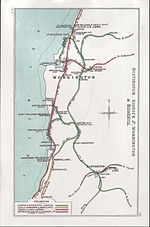Moss Bay Cart Siding railway station

Moss Bay Cart Siding was used for two periods as a temporary northern terminus for workmen's trains to Lowca. It was situated where Moss Bay Road crossed the CWJR's Derwent Branch in southern Workington in the former county of Cumberland, England, which is now part of Cumbria.No public passenger service ever called at the station. The first period of use began on 15 April 1912 when the new workmen's service to Micklam and Lowca began. The service was moved from the Cart Siding to start at Workington Central at some time before July 1913. This service ran along what would become the Lowca Light Railway (LLR). The second period of use began on 11 July 1915, when two Sundays Only workmen's trains commenced running to meet exceptional wartime need. This service was to run "for the duration." It is not mentioned in the CWJR's July 1920 Working Time Table. This service ran along the LLR. No photographs have been published of the station or its site. The track past the siding remained in use to serve Wilkinsons Wagon Works until 1962.By 2013 no trace of the site remained.
Excerpt from the Wikipedia article Moss Bay Cart Siding railway station (License: CC BY-SA 3.0, Authors, Images).Moss Bay Cart Siding railway station
Ashmore Gardens,
Geographical coordinates (GPS) Address Nearby Places Show on map
Geographical coordinates (GPS)
| Latitude | Longitude |
|---|---|
| N 54.628 ° | E -3.5634 ° |
Address
Ashmore Gardens
Ashmore Gardens
CA14 5DB , Mossbay
England, United Kingdom
Open on Google Maps







